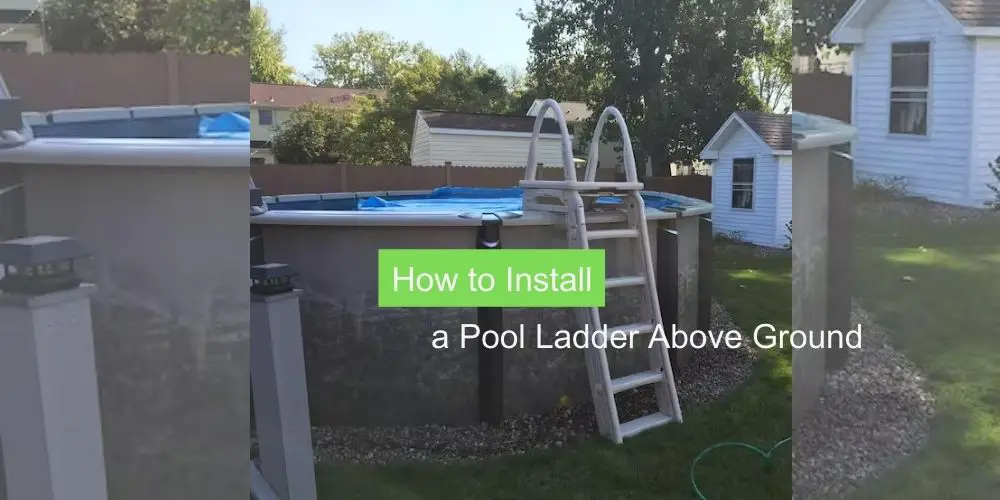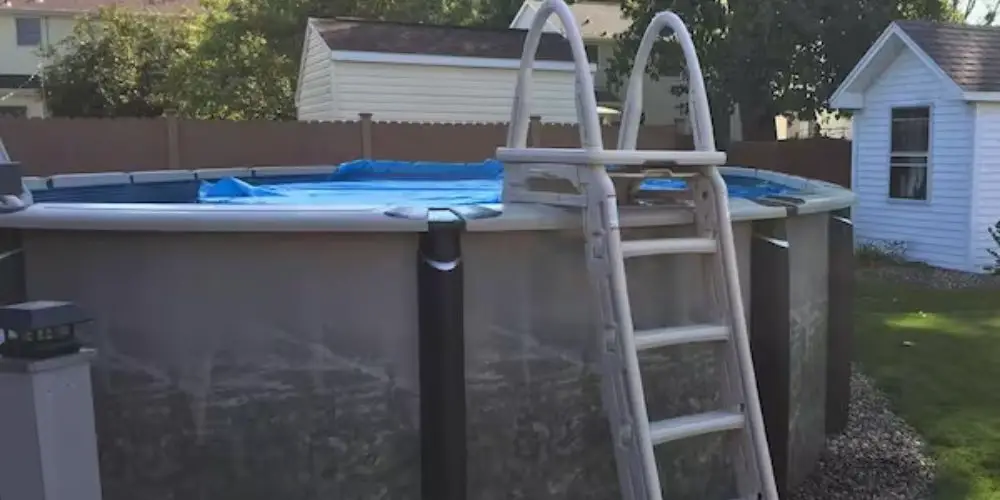
Pool ladders are a crucial addition to above-ground pools, providing safe and convenient access for swimmers. They offer a range of benefits and are an integral part of the pool installation process. In this blog, we will explore the importance of pool ladders, highlight their benefits, and provide an overview of the process on “How to Install a Pool Ladder Above Ground”. By understanding the significance of pool ladders and their installation, you can enhance the safety and enjoyment of your above-ground pool. Let’s dive in!
How to Install a Pool Ladder Above Ground

Preparing for Installation
Before you embark on installing a pool ladder for your above ground pool, it’s crucial to make adequate preparations. This section will guide you through the necessary steps to ensure a smooth and successful installation process.
Gathering Necessary Tools and Materials:
To install a pool ladder, you’ll need a few essential tools and materials. Here’s a checklist to help you gather everything you’ll need:
- Screwdriver or drill (depending on the ladder type)
- Measuring tape or ruler
- Pencil or marker for marking positions
- Level to ensure proper alignment
- Anchors or brackets (provided with the ladder or purchased separately)
- Screws or bolts (if not included with the ladder)
- Safety goggles and gloves for protection during installation
Having all the required tools and materials readily available will save you time and prevent unnecessary interruptions during the installation process.
Choosing the Right Type of Ladder for Your Pool:
When selecting a pool ladder, it’s important to consider your pool’s specific requirements. Factors such as pool size, shape, and depth should influence your decision. Common types of above ground pool ladders include A-frame ladders, deck-mounted ladders, and ladder systems with removable steps.
Evaluate your pool’s dimensions, weight capacity, and any special features it may have, such as a deck or a deep end. Ensure that the ladder you choose is compatible with your pool and meets your safety and accessibility needs.
Checking the Pool’s Condition and Measurements:
Before installation, inspect your pool to ensure it is in good condition. Look for any damages, cracks, or weaknesses in the pool wall or structure. Repair or address any issues before proceeding with ladder installation to maintain the pool’s integrity and safety.
Additionally, measure the height of your pool wall and the distance between the pool’s top edge and the ground. This will help determine the appropriate ladder height and positioning during installation.
Ensuring the Pool Area is Clear and Safe for Installation:
Before installing the ladder, it’s essential to clear the pool area of any obstructions or hazards that may interfere with the installation process or pose a safety risk. Remove any furniture, toys, or debris from around the pool.
Check the surroundings for any overhanging trees, low-hanging structures, or electrical equipment that may be in close proximity to the ladder installation area. Ensure there is ample space for safe entry and exit from the pool without any potential obstacles.
Taking the time to prepare adequately for the installation process will set a solid foundation for a successful pool ladder installation. By gathering the necessary tools and materials, choosing the right ladder type, checking the pool’s condition and measurements, and clearing the installation area, you are ready to move forward with confidence. In the next section, we will provide a detailed step-by-step guide to assist you in installing your pool ladder.
Step-by-Step Installation Guide
Installing a pool ladder for your above-ground pool requires a systematic approach. Follow this step-by-step guide to ensure a successful installation process:
Step 1: Positioning the Ladder
- Determine the ideal location: Consider factors such as pool shape, accessibility, and safety when choosing where to position the ladder. Find a spot that allows for easy entry and exit while maintaining stability.
- Mark the spots for ladder installation: Use a pencil or marker to clearly mark the positions where the ladder will be attached to the pool wall. Ensure the markings are level and aligned properly.
Step 2: Assembling the Ladder
- Unpack and inspect the ladder parts: Carefully unpack all the components of the ladder and inspect them for any damage or defects. Ensure that all necessary parts are included and in good condition.
- Read the instructions thoroughly: Before proceeding with assembly, carefully read and understand the manufacturer’s instructions. Each ladder may have specific requirements or variations in the assembly process.
- Attach the ladder pieces together: Following the instructions, assemble the ladder by connecting the different pieces securely. Use the provided hardware, such as screws or bolts, to fasten the components together.
Step 3: Securing the Ladder to the Pool Wall
- Drill holes in the pool wall, if necessary: Depending on the ladder type and your pool’s design, you may need to drill holes in the pool wall to accommodate the ladder anchors or brackets. Ensure that the holes are the correct size and positioned accurately.
- Insert and tighten ladder anchors or brackets: Insert the ladder anchors or brackets into the pre-drilled holes. Use a screwdriver or appropriate tool to tighten them securely to the pool wall. Double-check the stability and alignment of the ladder to ensure it is properly positioned.
Step 4: Adjusting Ladder Height (if applicable)
- Follow the manufacturer’s instructions for height adjustment: If your ladder has adjustable height options, refer to the manufacturer’s instructions to determine the correct adjustment process. Some ladders may require loosening or tightening specific components to achieve the desired height.
- Ensure the ladder is at the appropriate height for safe entry and exit: Adjust the ladder’s height according to the depth of your pool. It should provide comfortable and safe access for users. Double-check that the ladder is securely locked in the adjusted position.
Step 5: Testing the Ladder
- Check the ladder’s stability and weight capacity: Before using the ladder, ensure it can support the weight capacity specified by the manufacturer. Test the ladder’s stability by applying pressure and verifying that it remains secure.
- Verify the ladder’s functionality and ease of use: Test the ladder’s steps, handrails, and overall functionality. Ascend and descend the ladder to ensure it provides a safe and comfortable experience for users.
By following this step-by-step guide, you’ll be able to install your pool ladder correctly and ensure its stability, functionality, and safety. With the ladder securely in place, you’re one step closer to enjoying your above-ground pool to the fullest!
Safety Precautions and Maintenance Tips
After installing a pool ladder for your above-ground pool, it’s crucial to prioritize safety and maintenance to ensure a secure and enjoyable swimming experience. Here are some essential safety precautions and maintenance tips to follow:
1. Ensuring the Ladder is Securely Installed:
Double-check the ladder’s stability and ensure that it is firmly secured to the pool wall. Periodically inspect the ladder’s attachment points, such as anchors or brackets, to ensure they remain tight and in good condition. If you notice any signs of loosening or instability, promptly address and fix the issue to prevent accidents.
2. Regularly Inspecting the Ladder for Signs of Wear and Tear:
Inspect the ladder regularly for any signs of wear, damage, or corrosion. Pay close attention to the ladder steps, handrails, and fastening mechanisms. Look for cracks, rust, or any sharp edges that may pose a safety risk. If you notice any issues, repair or replace the ladder components as needed.
3. Cleaning the Ladder to Prevent Slipperiness:
Pool ladders can become slippery over time due to algae growth or other substances. Regularly clean the ladder to prevent slip hazards. Use a mild detergent or pool-safe cleaner along with a brush or sponge to scrub away any grime or buildup. Rinse thoroughly with water to remove any cleaning residue.
4. Promoting Safe Usage Guidelines for Pool Ladder:
Educate all pool users, especially children, about safe ladder usage guidelines. Encourage them to use the ladder one person at a time, to hold onto the handrails while climbing, and to refrain from running or jumping onto the ladder. Remind swimmers to enter and exit the pool facing the ladder and to exercise caution to prevent slips or falls.
5. Addressing Common Ladder-Related Safety Concerns:
There are some common safety concerns associated with pool ladders that should be addressed:
- Avoid using the ladder if it is damaged or unstable.
- Do not exceed the ladder’s weight capacity.
- Keep the ladder area clear of objects that may obstruct safe access.
- Be cautious of pool covers or other accessories that may interfere with ladder usage.
- Supervise children at all times when using the pool ladder.
By implementing these safety precautions and maintenance tips, you can ensure that your pool ladder remains safe, functional, and durable over time. Regular inspection, cleaning, and promoting safe usage guidelines will contribute to a safer and more enjoyable pool environment for everyone.
Remember, safety should always be a top priority when it comes to swimming pool equipment. With proper care and maintenance, your pool ladder will continue to provide reliable and secure access for years to come.

Hi, This is Josh. I am a former competitive swimmer and current fitness enthusiast.
I created this site to share my love of swimming with the world!

